7.5: Kingdom of Champa (192 CE -1832 CE)
- Page ID
- 219996
\( \newcommand{\vecs}[1]{\overset { \scriptstyle \rightharpoonup} {\mathbf{#1}} } \)
\( \newcommand{\vecd}[1]{\overset{-\!-\!\rightharpoonup}{\vphantom{a}\smash {#1}}} \)
\( \newcommand{\id}{\mathrm{id}}\) \( \newcommand{\Span}{\mathrm{span}}\)
( \newcommand{\kernel}{\mathrm{null}\,}\) \( \newcommand{\range}{\mathrm{range}\,}\)
\( \newcommand{\RealPart}{\mathrm{Re}}\) \( \newcommand{\ImaginaryPart}{\mathrm{Im}}\)
\( \newcommand{\Argument}{\mathrm{Arg}}\) \( \newcommand{\norm}[1]{\| #1 \|}\)
\( \newcommand{\inner}[2]{\langle #1, #2 \rangle}\)
\( \newcommand{\Span}{\mathrm{span}}\)
\( \newcommand{\id}{\mathrm{id}}\)
\( \newcommand{\Span}{\mathrm{span}}\)
\( \newcommand{\kernel}{\mathrm{null}\,}\)
\( \newcommand{\range}{\mathrm{range}\,}\)
\( \newcommand{\RealPart}{\mathrm{Re}}\)
\( \newcommand{\ImaginaryPart}{\mathrm{Im}}\)
\( \newcommand{\Argument}{\mathrm{Arg}}\)
\( \newcommand{\norm}[1]{\| #1 \|}\)
\( \newcommand{\inner}[2]{\langle #1, #2 \rangle}\)
\( \newcommand{\Span}{\mathrm{span}}\) \( \newcommand{\AA}{\unicode[.8,0]{x212B}}\)
\( \newcommand{\vectorA}[1]{\vec{#1}} % arrow\)
\( \newcommand{\vectorAt}[1]{\vec{\text{#1}}} % arrow\)
\( \newcommand{\vectorB}[1]{\overset { \scriptstyle \rightharpoonup} {\mathbf{#1}} } \)
\( \newcommand{\vectorC}[1]{\textbf{#1}} \)
\( \newcommand{\vectorD}[1]{\overrightarrow{#1}} \)
\( \newcommand{\vectorDt}[1]{\overrightarrow{\text{#1}}} \)
\( \newcommand{\vectE}[1]{\overset{-\!-\!\rightharpoonup}{\vphantom{a}\smash{\mathbf {#1}}}} \)
\( \newcommand{\vecs}[1]{\overset { \scriptstyle \rightharpoonup} {\mathbf{#1}} } \)
\( \newcommand{\vecd}[1]{\overset{-\!-\!\rightharpoonup}{\vphantom{a}\smash {#1}}} \)
\(\newcommand{\avec}{\mathbf a}\) \(\newcommand{\bvec}{\mathbf b}\) \(\newcommand{\cvec}{\mathbf c}\) \(\newcommand{\dvec}{\mathbf d}\) \(\newcommand{\dtil}{\widetilde{\mathbf d}}\) \(\newcommand{\evec}{\mathbf e}\) \(\newcommand{\fvec}{\mathbf f}\) \(\newcommand{\nvec}{\mathbf n}\) \(\newcommand{\pvec}{\mathbf p}\) \(\newcommand{\qvec}{\mathbf q}\) \(\newcommand{\svec}{\mathbf s}\) \(\newcommand{\tvec}{\mathbf t}\) \(\newcommand{\uvec}{\mathbf u}\) \(\newcommand{\vvec}{\mathbf v}\) \(\newcommand{\wvec}{\mathbf w}\) \(\newcommand{\xvec}{\mathbf x}\) \(\newcommand{\yvec}{\mathbf y}\) \(\newcommand{\zvec}{\mathbf z}\) \(\newcommand{\rvec}{\mathbf r}\) \(\newcommand{\mvec}{\mathbf m}\) \(\newcommand{\zerovec}{\mathbf 0}\) \(\newcommand{\onevec}{\mathbf 1}\) \(\newcommand{\real}{\mathbb R}\) \(\newcommand{\twovec}[2]{\left[\begin{array}{r}#1 \\ #2 \end{array}\right]}\) \(\newcommand{\ctwovec}[2]{\left[\begin{array}{c}#1 \\ #2 \end{array}\right]}\) \(\newcommand{\threevec}[3]{\left[\begin{array}{r}#1 \\ #2 \\ #3 \end{array}\right]}\) \(\newcommand{\cthreevec}[3]{\left[\begin{array}{c}#1 \\ #2 \\ #3 \end{array}\right]}\) \(\newcommand{\fourvec}[4]{\left[\begin{array}{r}#1 \\ #2 \\ #3 \\ #4 \end{array}\right]}\) \(\newcommand{\cfourvec}[4]{\left[\begin{array}{c}#1 \\ #2 \\ #3 \\ #4 \end{array}\right]}\) \(\newcommand{\fivevec}[5]{\left[\begin{array}{r}#1 \\ #2 \\ #3 \\ #4 \\ #5 \\ \end{array}\right]}\) \(\newcommand{\cfivevec}[5]{\left[\begin{array}{c}#1 \\ #2 \\ #3 \\ #4 \\ #5 \\ \end{array}\right]}\) \(\newcommand{\mattwo}[4]{\left[\begin{array}{rr}#1 \amp #2 \\ #3 \amp #4 \\ \end{array}\right]}\) \(\newcommand{\laspan}[1]{\text{Span}\{#1\}}\) \(\newcommand{\bcal}{\cal B}\) \(\newcommand{\ccal}{\cal C}\) \(\newcommand{\scal}{\cal S}\) \(\newcommand{\wcal}{\cal W}\) \(\newcommand{\ecal}{\cal E}\) \(\newcommand{\coords}[2]{\left\{#1\right\}_{#2}}\) \(\newcommand{\gray}[1]{\color{gray}{#1}}\) \(\newcommand{\lgray}[1]{\color{lightgray}{#1}}\) \(\newcommand{\rank}{\operatorname{rank}}\) \(\newcommand{\row}{\text{Row}}\) \(\newcommand{\col}{\text{Col}}\) \(\renewcommand{\row}{\text{Row}}\) \(\newcommand{\nul}{\text{Nul}}\) \(\newcommand{\var}{\text{Var}}\) \(\newcommand{\corr}{\text{corr}}\) \(\newcommand{\len}[1]{\left|#1\right|}\) \(\newcommand{\bbar}{\overline{\bvec}}\) \(\newcommand{\bhat}{\widehat{\bvec}}\) \(\newcommand{\bperp}{\bvec^\perp}\) \(\newcommand{\xhat}{\widehat{\xvec}}\) \(\newcommand{\vhat}{\widehat{\vvec}}\) \(\newcommand{\uhat}{\widehat{\uvec}}\) \(\newcommand{\what}{\widehat{\wvec}}\) \(\newcommand{\Sighat}{\widehat{\Sigma}}\) \(\newcommand{\lt}{<}\) \(\newcommand{\gt}{>}\) \(\newcommand{\amp}{&}\) \(\definecolor{fillinmathshade}{gray}{0.9}\)Introduction
Initially, the South China Sea was called the Champa Sea (7.5.1), named for the empire that controlled central Vietnam and included parts of eastern Cambodia and Laos. The kingdom’s peak was from the 6th to the 15th centuries when it was controlled by multiple rulers in different provinces. Artifacts attributed to the Chams were found dated back to the second century CE. The Cham had trade routes extending into China, Japan, and other Southeast Asian countries, right in the middle Maritime Silk Road routes. They gained great wealth in trade and transportation of goods, including precious metals, gems, spices, unusual animals, and enslaved people. “During Champa’s golden age, a Muslim geographer wrote that the islands ‘produced ivory, camphor, nutmeg, mace, cloves, agarwood, cardamom, cubed, and other substances.’”[1]

Hinduism was adopted as a religion early in the kingdom’s history and probably converted by traveling Indian merchants. By the end of the 10th century, Muslim traders brought Islam. The Hindu Cham were known as Balamon, and the Muslim Cham were called Bani. Both religions celebrated their practices; however, they both followed ancestor worship and shared some deities. Red-brick temples and towers were a significant legacy of the period. Many of the ancient buildings were destroyed by bombings in the Vietnam War, and others are in jeopardy from today’s commercial enterprises. The modern Vietnamese also build Buddhist temples on top of ruined Cham religious sites.
Mỹ Sơn
The ancient kingdoms in Southeast Asia constructed multiple temple sites with the Mỹ Sơn sanctuary is one of the finest surviving sites. The temples were built in the 4th to the 13th centuries by the Chams in southern Vietnam (7.5.2), and they incorporated Hindu art with local culture. Located in a valley two kilometers wide and bordered by mountains, the site was built for the God Shiva at Mỹ Sơn and associated with the theories of mountain and father. The sanctuary was a place for the kings’ religious ceremonies and a burial site for royalty and heroes. Today, the site is still a spiritual place for the Cham people, a minority group in Vietnam.
The more than seventy temples (7.5.3) were constructed from fired red clay bricks with carvings directly into the brick (7.5.4). Only one temple was made from stone. Four types of buildings were built, including a sanctuary to house the deity (kalan), an entry hallway (mandapa), a storehouse (7.5.5) (kosagrha), and gate towers (gopura). The architectural designs symbolize the mountain home of the Hindu gods. Historians note the importance of music and dance for the royal court, especially those following specific types of Hindu practitioners. The Pashupatas traveled throughout the region to teach and as specialists in using music in religious rituals, and their images were frequently used in carvings. In addition to the temples, they constructed multiple sculptures, statues, and stelae. The stele (32 found) is a stone tower incised with important cultural events and acts as a historical document. The stelae provided historians with information about the Cham people and their culture.
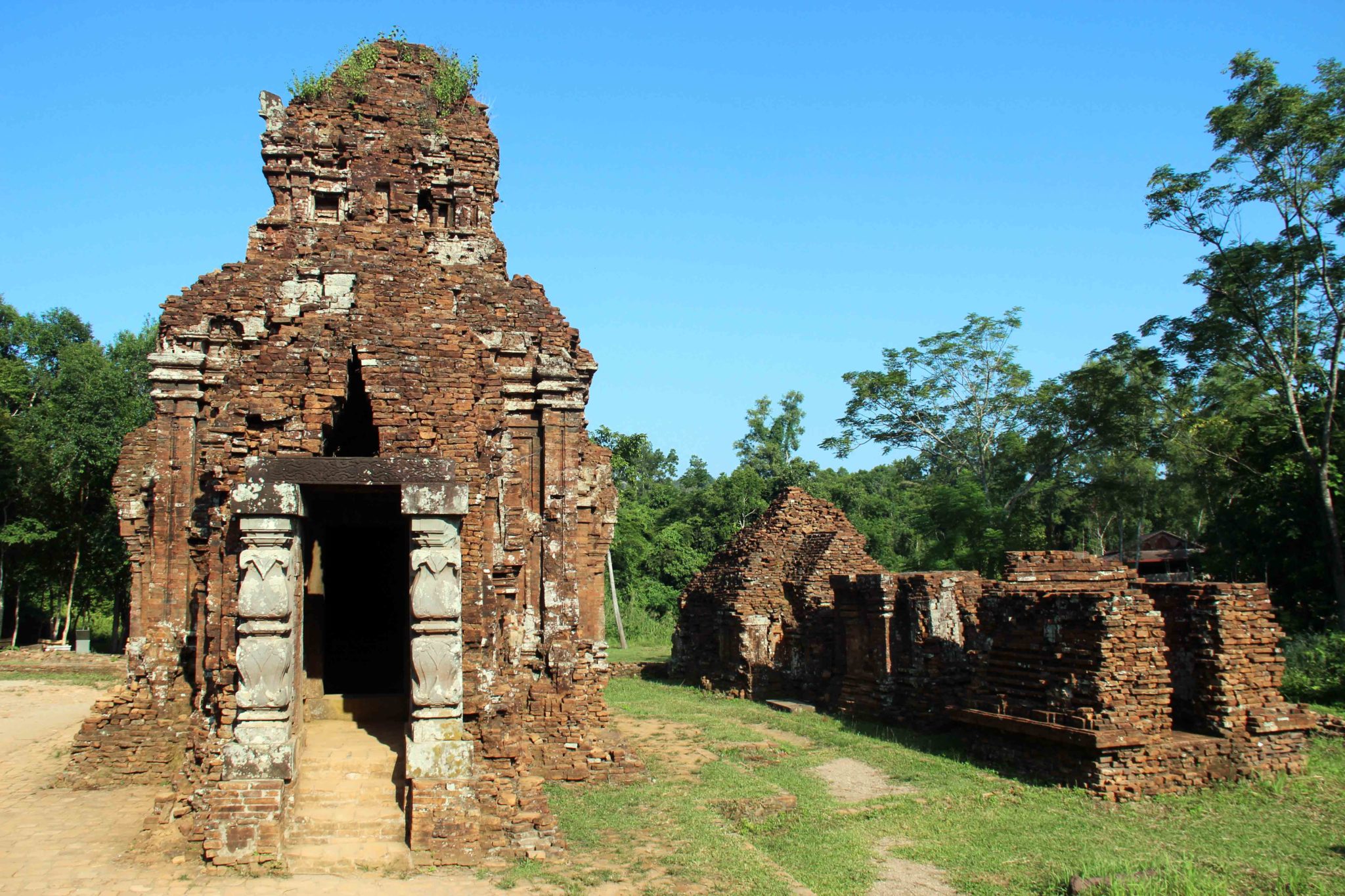
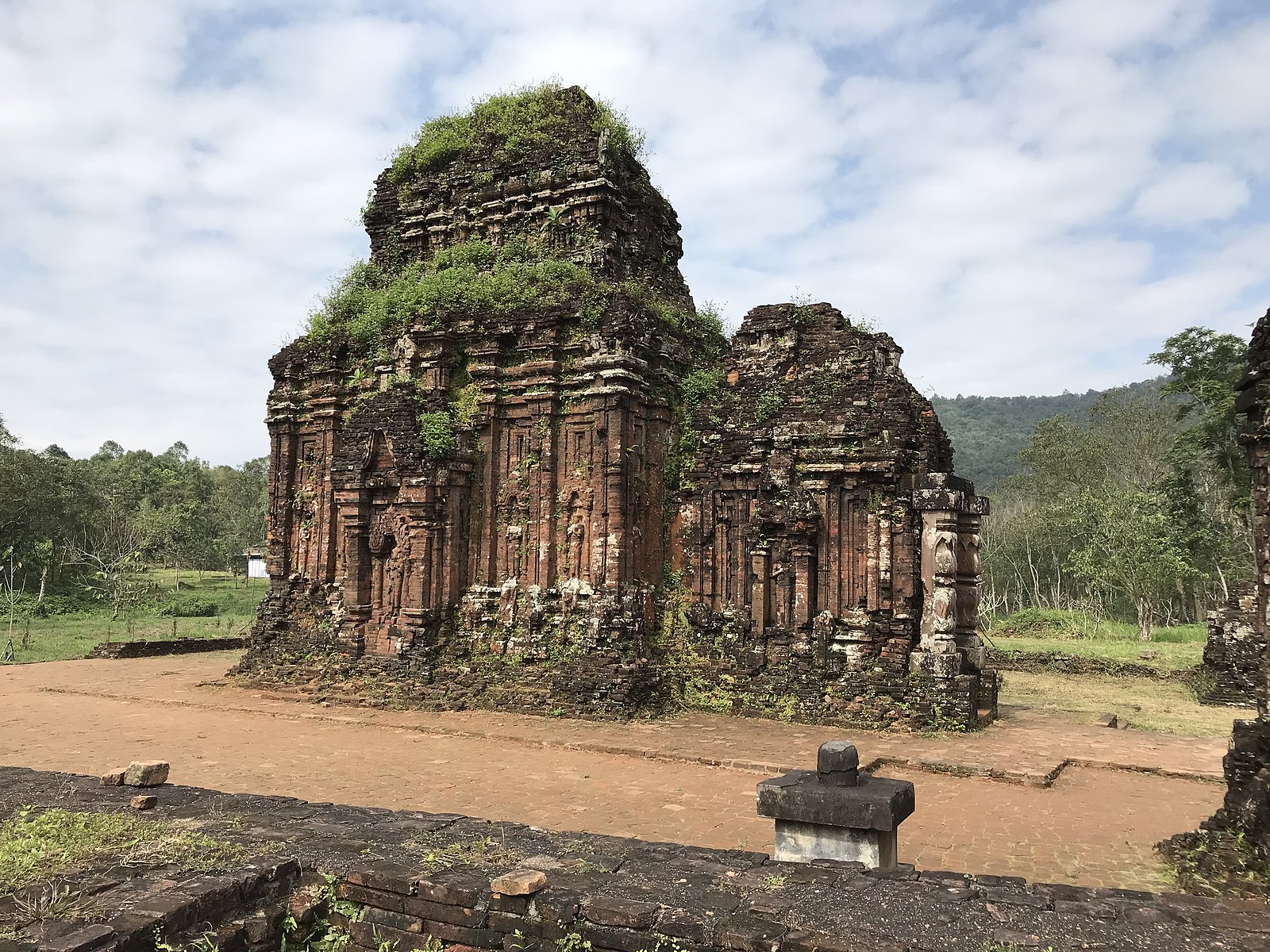
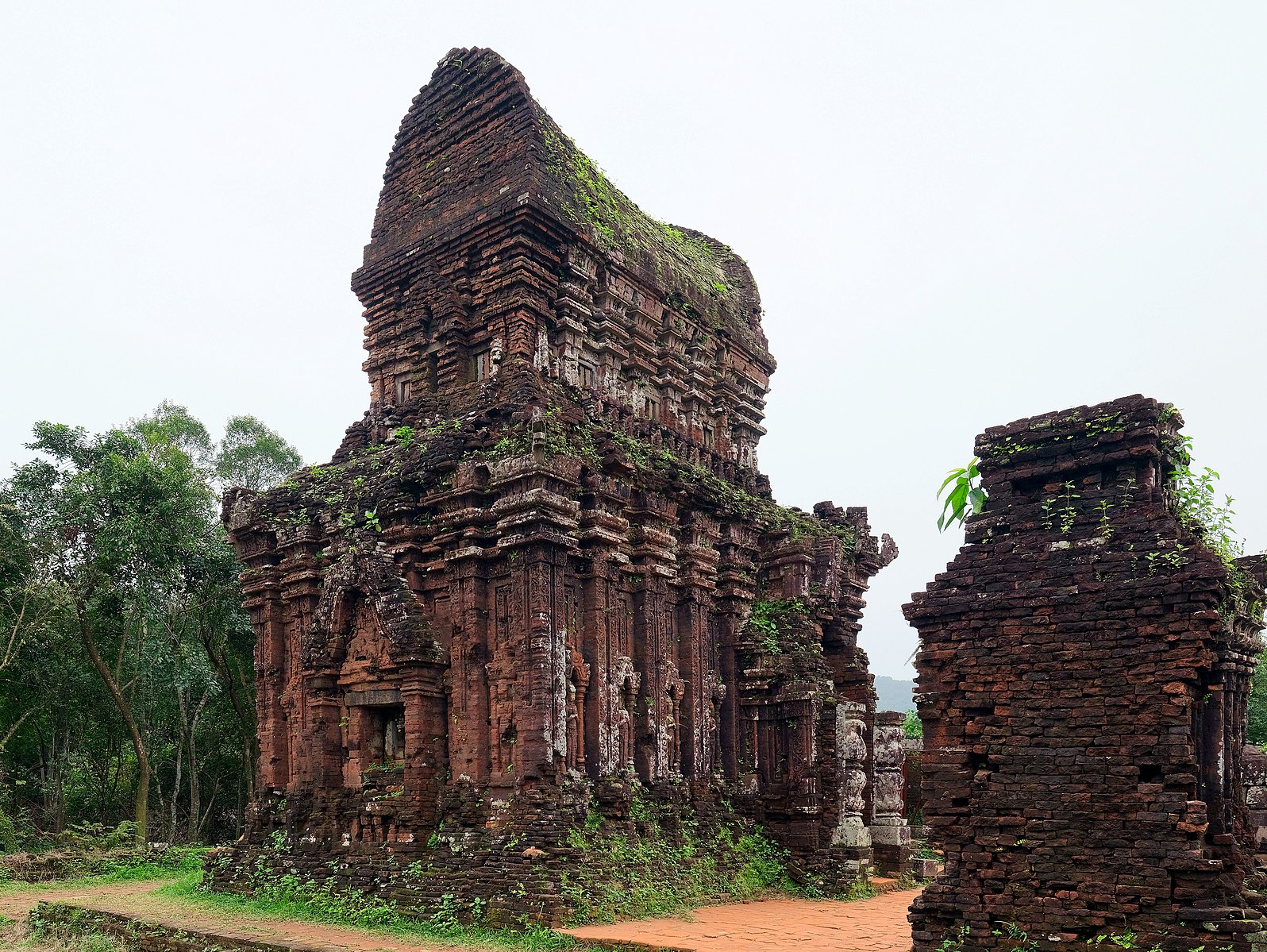
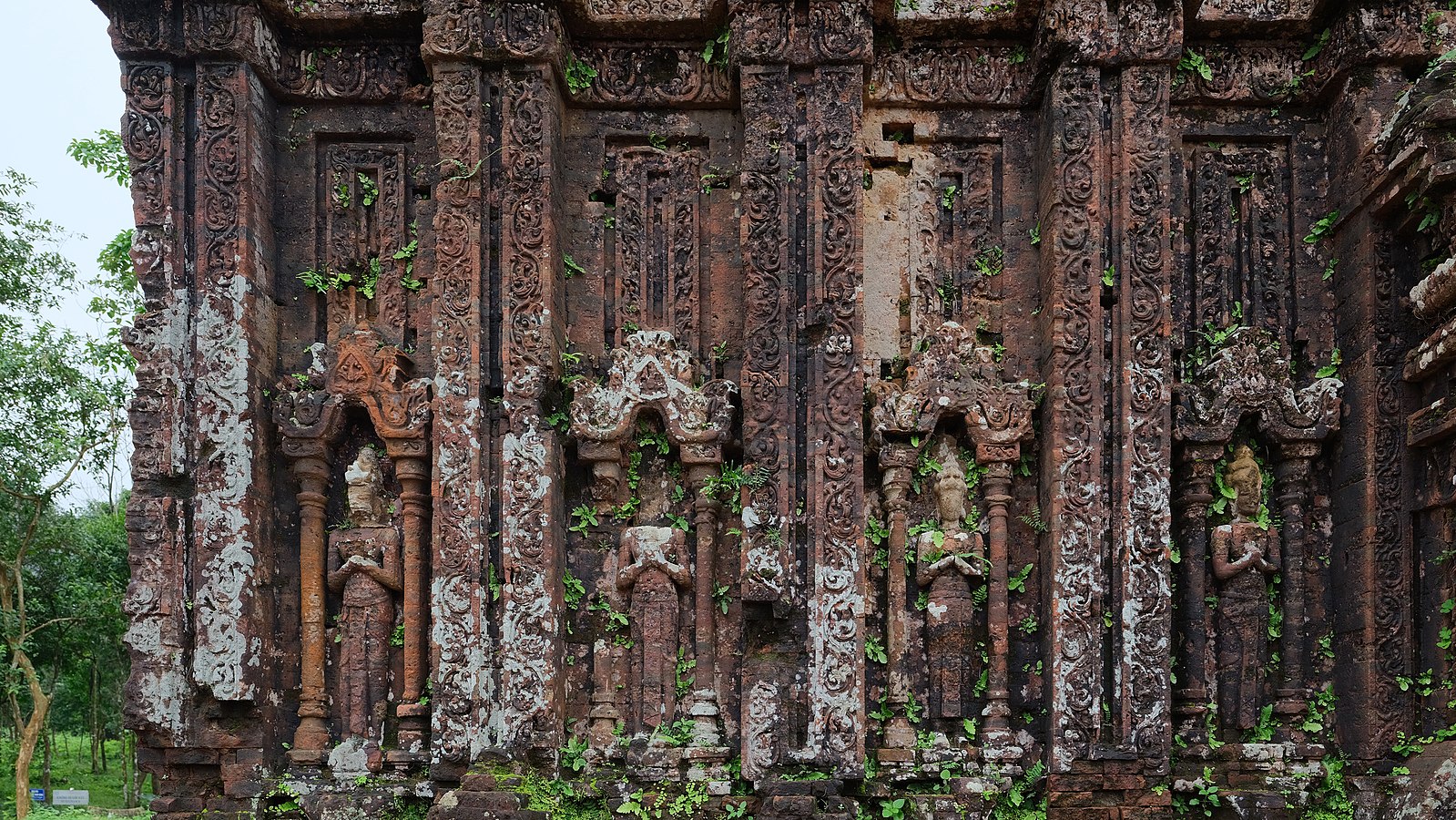
“The royal court’s connection to the sacred realm is made evident in a 7th/8th-century lintel that was once on the doorway of the Mỹ Sơn E1 temple housing the Mỹ Sơn E1 pedestal. Anyone entering the temple would have passed directly below it. The lintel depicts Visnu Anantasayana and the birth of Brahma. The lintel shows the two-armed Visnu (preserver and protector of the universe) lying under a naga king (a divine deity believed to be half-human and half-cobra). A brahmin appears behind Visnu, with his hands raised, perhaps to evoke or communicate with the deity. On top of the lintel, Brahma (7.5.6) is seated, cross-legged, on a lotus flower above Visnu.”[2]
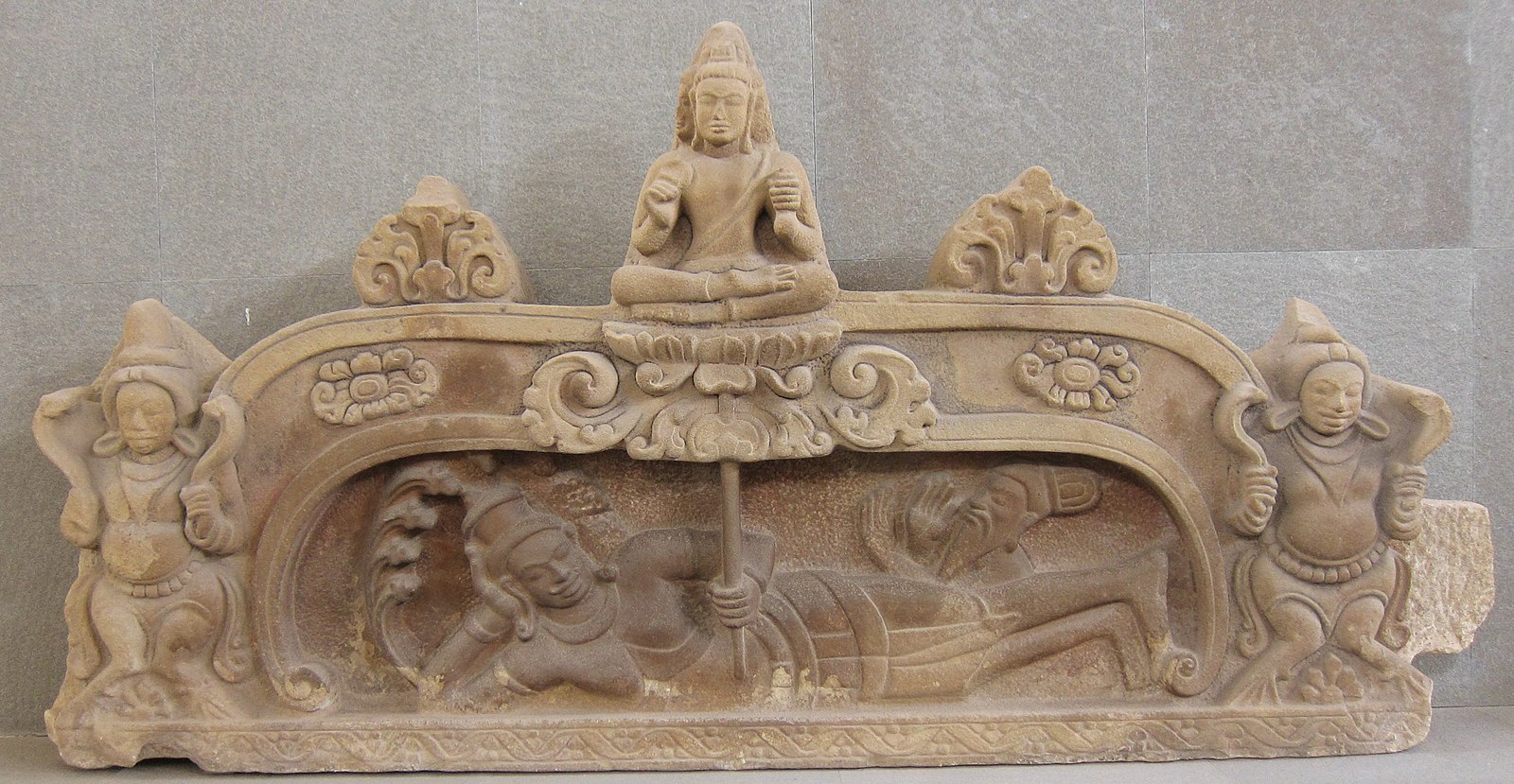
Mỹ Sơn Sanctuary is a beautiful and impressive UNESCO World Heritage Site. Built in the jungle about an hour's drive from Hoi An in central Vietnam, My Son is a large ruined Hindu temple complex that dates from the 4th century. Most of the buildings here date from the 10th century and were built by the Champa Kingdom, who once ruled these lands. Sadly, the site suffered heavy damage during the Vietnam war, and many of the temple buildings were completely destroyed. Let's go exploring!
Đồng Dương Style of Art
One of the Cham kings, Indravarman II (?-893), did not follow the traditional Hindu practices and used Buddhism for religious rituals. The change also brought a different style of sculpture with an exaggerated or extreme set of features known as the Đồng Dương style. The figures do not smile and have thick noses and lips. Most of the sculptures are based on figures representing the life of Buddha or other supporting images. The Đồng Dương complex included a long-destroyed temple and other buildings, including a walled enclosure.
The Dvarapalas (7.5.7) were usually placed in pairs as demigods who guarded the gateways and were found in Hindu and Buddhist gateways. The Dvarapalas is made from sandstone and is pictured stomping on a bull as it spits out a small warrior. The figure has oversized lips and appears to have slain the bull as he celebrates. The elaborate headdress represents his powerful position in life. The Dharmapala (7.5.8) is also a protector and is supposed to prevent obstacles so that spiritual believers can obtain their spiritual objectives without problems. Although the Dharmapala is seated, it maintains its position of power with its appearing solid body, large hands, and a don’t bother me look.

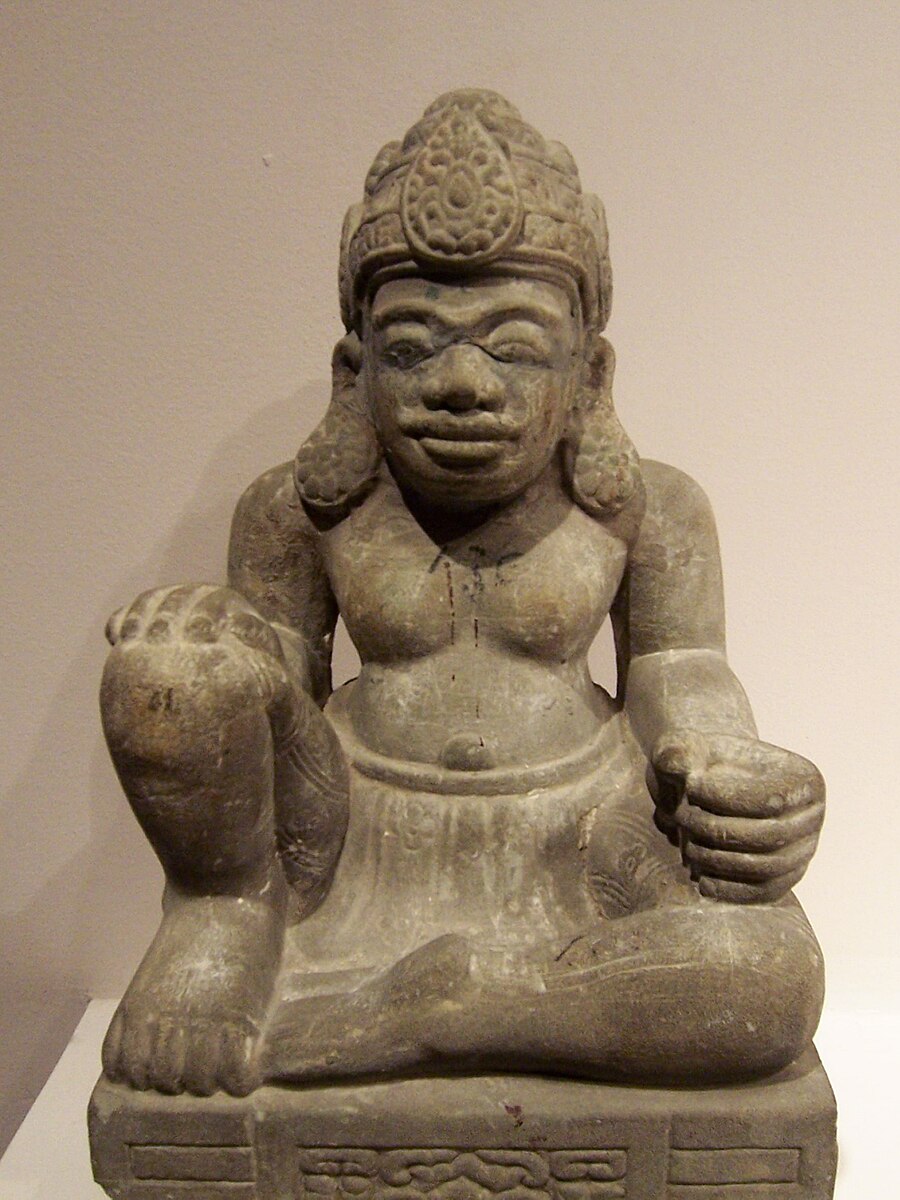
Trà Kiệu Style of Art
Although Trà Kiệu was the first capital of the Champa Kingdom from the 4th to 8th century, it was hidden in the jungles until the late 19th century. Little remains from the buildings of the area. Archaeologists have found two different types of ceramics for roof tiles. One style had textile impressions for the ordinary house, and the other was roof tiles made with faces on them. Faces on roof tiles were found in other places; however, the tiles in Trà Kiệu had face motifs because of Hinduism, and the tiles in China had the Buddhist lotus image.
The Trà Kiệu Pedestal (7.5.9) was made into an immense lingam and was a place to clean your hands. The pedestal is one of the masterpieces of the period’s art. The lingam is an abstract version of the Hindu god Shiva. They are usually composed of a disc-shaped platform with a vertical lingam. Around the base are images representing parts of Krishna’s life. Perched in each corner is a figure with a lion’s head, each appearing to hold the weight of the pedestal. The other pedestal was the Dancers’ Pedestal (7.5.10) and a similar masterpiece. Each corner has a dancing apsara accompanied by the gandharva playing the music. The apsara was the female spirit representing clouds and water, which was common in many artworks. The gandharva were males who were celestial demigods serving as musicians.

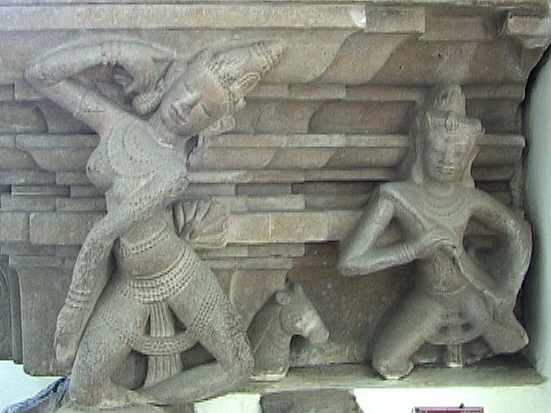
Tháp Mẫm Style of Art
During the 1934 excavation in Tháp Mẫm, over fifty-eight tons of artifacts were found. The style of sculptures was considered detailed; however, historians also characterized the works as stereotypical, without any individualism or liveliness. Art in Tháp Mẫm was created towards the end of the Champa Kingdom and was considered the declining art period. The pedestal (7.5.11) is one of the sculptures found in the 1934 excavations. Around the four sides is a row of female breasts with two bands of a flame-shaped image. Using female breasts was a popular subject and a representation of fertility. A lion image appears to be holding up two of the corners of the pedestal, and a garuda (7.5.12) at the other two corners. The garuda was a Hindu mythical eagle-like bird frequently shown with Vishnu.
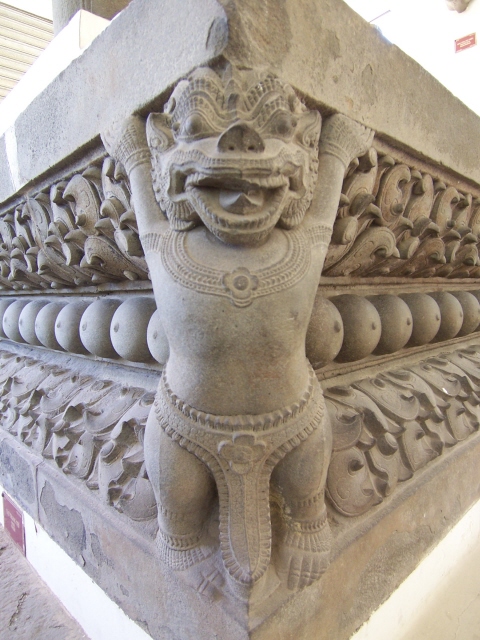

[2] Mỹ Sơn Hindu temple complex Retrieved from https://smarthistory.org/my-son-hindu-temple-complex/


